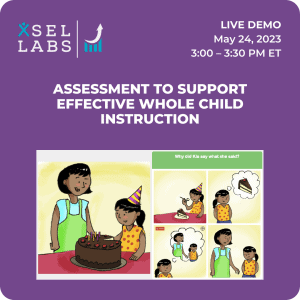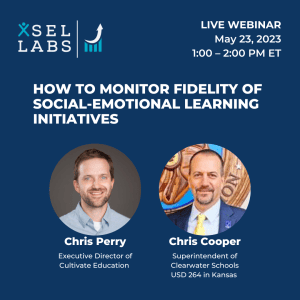A few weeks ago, I had the honor of speaking about SEL assessment at a convening of the National Governors Association (NGA) on workforce development. States are trying to figure out how much and how they want to support educational initiatives targeted to students’ social and emotional development, and the NGA convened this meeting to help governors and their staffs sort through these issues.
The conversation was energetic and inspiring and I was heartened by the excellent work that policy makers and others are doing in a bipartisan way to figure out how to support student success. As one of many speakers at the meeting, I shared my views of the role of social and emotional competence assessment (see State of the Field Report). Others also shared their views of the role of assessment.
Climate Versus Competence: A Peculiar Rivalry
As the meeting unfolded and experts shared their views of assessment, one thing struck me: there is a tension in the field of social and emotional learning about what should be assessed (and addressed). The tension lay between those who advocated an exclusive focus on assessing climate and those who advocated assessing student social and emotional competence.
The climate advocates argue that for students to succeed at school, adults need to create a positive climate learning in schools, and unless we do that, competence-focused initiatives won’t work. Climate typically refers to students’ perceptions of safety, relationships with peers and adults, and instructional quality. Climate advocates argue that to create the conditions for learning, we should assess those conditions and use assessment data to guide our efforts to improve the learning climate. They are motivated by a belief—supported by evidence—that creating positive conditions for learning is associated with positive student outcomes.
In another camp are those who feel passionately that we should intentionally teach students the social and emotional competencies they need to succeed in school and life, and that only through this intentional work can we effectively support student social and emotional development. Social and emotional competencies generally refers to the skills, knowledge and dispositions needed to interact effectively with others and to form positive relationships. This includes the competencies described in the CASEL model, for example. Those who focus on assessing competence argue that to teach competencies effectively, we should assess student competence and use assessment data to inform what we teach to whom, and to measure student progress, much as we do for reading and math. Like the climate camp, those who focus on competence are supported by evidence that teaching SEL leads to positive student outcomes.
I would venture to guess that, like me, most people who believe it is important to assess and address student competencies also believe that creating positive conditions for learning is important. So the two camps are really: (1) those who advocate an exclusive focus on the conditions for learning and (2) those who, in addition to caring about the conditions for learning, believe students should be intentionally taught social and emotional competencies.
Some who advocate a focus on climate also express concern about the potential negative impact of teaching competencies. The concern, I think, is that unless the climate is broadly supportive and equitable, focusing on student competence might become a thinly disguised form of discipline practice, and that this could perpetuate inequity by, for example, disproportionate disciplinary referrals that are just named something else. Many express concern that students—particularly students of color—will be labeled as “low SEL” kids, with negative downstream consequences. I understand that concern. I don’t see a lot of evidence that it actually happens, but I understand it.
Opinion Versus Fact (in My Opinion)
Whenever there is a tension like this, I like to go to the evidence. Here are some facts: The very best research supports these conclusions: (1) climate and adult practice—particularly student safety, relationship quality, and instructional support—are associated with student outcomes; (2) social and emotional competencies like those described in the CASEL model are associated with student success in school and life; (3) teaching students social and emotional competencies through high-quality SEL instruction supports academic, behavioral and emotional development; and (4) the benefit of well-taught SEL programs accrues equally to children from different ethnic and socioeconomic groups, and that the benefit is particularly pronounced for children who are showing some signs of emotional or behavioral challenges (Tier II kids).
On the other hand, as far as I can tell, I have sought, but could not find, data to suggest that teachers use SEL programs to engage in racially divisive disciplinary practices or exercises in social control. Could it happen? Yes. Does it regularly happen? We really don’t know. I could also not find evidence that for SEL programs to be effective, climate and culture needs to be addressed first. So my view is that the fear expressed by climate advocates that a focus on competence is dangerous is not supported by the evidence and should therefore be considered a testable hypothesis. To be clear, this is an important hypothesis. But the strong stance that climate must be the exclusive focus and that a focus on competence is dangerous—and the variant that climate needs to be addressed before competence—are opinions, not evidence-based claims. Moreover, to the extent that these claims discourage educators from productively assessing and addressing student competencies, they are potentially harmful.
From Rivalry to Collaboration in SEL Assessment
More than half of school districts have adopted an evidence-based SEL program. The xSEL Labs team gets daily calls from educators in those districts who say they are not sure what competencies to focus on, or whether their efforts are making any difference. They are looking for some form of competence assessment to guide their instruction, much in the way a good reading or math test might help a teacher decide what reading or math skills to teach to whom at what point. It seems only wise to provide educators with the tools they need to use their SEL resources effectively.
In the best of all worlds, I would have educators assess the conditions for learning AND student social and emotional competence, and use both kinds of assessment data wisely to support teaching, learning, and student outcomes. Educators can use climate data to make decisions about what adult practices to change to increase student sense of safety, foster high-quality relationships, and enhance instructional opportunity. And they can use student competence assessment data to decide what student competencies to teach to what students at what point in the school year, and to measure student progress.
(Aside: colleagues at AIR wrote a terrific brief on the topic…)
In my view, these forms of assessment can play a key role in continuous practice improvement where assessment data informs practice and measures progress over time. I’ve written about data-informed instruction in my book and in this guide to continuous improvement. Those works focus on student competence assessment, but the key points apply to all kind of SEL assessment.
The idea that we ought to assess climate and competence is not mine alone. A National Practitioner Advisory Group recently published a consensus statement on SEL assessment. They recognized the importance of strengths-based SEL assessment to the teaching and learning enterprise AND the importance of organizational culture and climate.
In the spirit of social and emotional learning, I hope that advocates in our field will be able to look beyond a narrow either/or view (climate OR competence) and embrace a more integrative and, I believe, healthier both/and view (climate AND competence). As with many things, we are better together. Climate and competence is no exception.



